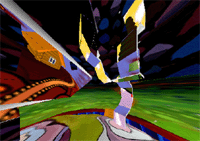Framing the Magic
January 15th, 2006
Categories: VR Art

Authors
Tsoupikova, D.About
This paper will explore how the aesthetics of the virtual world affects, transforms, and enhances the immersive emotional experience of the user. What we see and what we do upon entering the virtual environment influences our feelings, mental state, physiological changes and sensibility. To create a unique virtual experience the important component to design is the beauty of the virtual world based on the aesthetics of the graphical objects such as textures, models, animation, and special effects. The aesthetic potency of the images that comprise the virtual environment can make the immersive experience much stronger and more compelling. The aesthetic qualities of the virtual world as born out through images and graphics can influence the user’s state of mind. Particular changes and effects on the user can be induced through the application of techniques derived from the research fields of psychology, anthropology, biology, color theory, education, art therapy, music, and art history. Many contemporary artists and developers derive much inspiration for their work from their experience with traditional arts such as painting, sculpture, design, architecture and music. This knowledge helps them create a higher quality of images and stereo graphics in the virtual world. The understanding of the close relation between the aesthetic quality of the virtual environment and the resulting human perception is the key to developing an impressive virtual experience.
Resources
Citation
Tsoupikova, D., Framing the Magic, IS&T / SPIE 2006, The Engineering Reality of Virtual Reality 2006, vol 2006, San Jose, California, spie.org, Cees de Laat, January 15th, 2006.